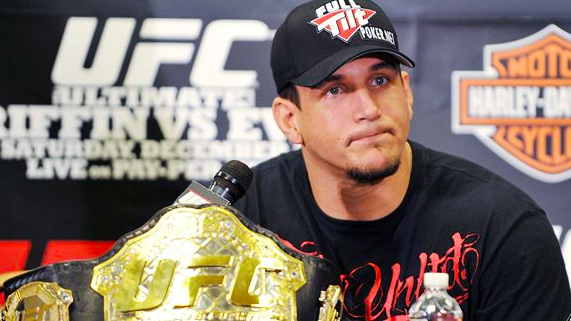# Frank Mir’s Realization of Being Underpaid for UFC 100 Fight
Frank Mir was the headliner of UFC’s record-breaking event UFC 100 against Brock Lesnar, but his pay did not reflect the event’s success. This historic event took place at the Mandalay Bay Events Center on July 11, 2009, as the UFC’s 100th anniversary celebration. The main event featured the blockbuster heavyweight championship clash between former WWE superstar turned MMA fighter Brock Lesnar and division mainstay Frank Mir. UFC 100 drew a massive audience of 1.6 million pay-per-view buys, making it the biggest UFC event at the time and still holding the position as the promotion’s fifth-highest grossing event.
The event, which generated $71 million in revenue from a $44.95 premium card, was split 50-50 with the cable provider, leaving the UFC with about $35 million. Mir, who was the face of this monumental event, reportedly only received $45,000, a mere 10% of Lesnar’s $400,000 earnings, and this was exclusive of any pay-per-view bonuses.
Even after all calculations, Mir ended up with less than $1 million from the event. Throughout his 15-year tenure in the UFC, Mir never crossed the million-dollar mark, making him one of the most underpaid fighters in UFC history. It was only much later that Mir noticed the stark pay disparity to his dismay.
“I think it was Deontay Wilder that finally made me realize.” [rematch] With Tyson Fury,” Mir said. mixed martial arts martial arts. “Me and Brock bought more merchandise than they did, but we’re looking at the cost of pay-per-view. Yes, there was money. Who did it go to? If they combined To see him make $40 million. It’s like, wow. Brock obviously made seven figures. I think he made $2.5 million. But he didn’t even make a million. .”

The Wilder vs. Fury fight, which garnered roughly half the UFC 100 buys at 800,000 to 850,000, highlights the significant difference in payouts. Despite the higher price tag of $79.99, the event pulled in $66 million, with both Wilder and Fury guaranteed more than $25 million each plus a share of the PPV revenue. This indicated a considerable shift in pay scales from Mir and Lesnar’s earnings in their fight.
“Brock himself is a much bigger superstar than he is.” [Fury or Wilder]” said Mill. “Why didn’t he make $20 million? That’s shocking to me and I don’t understand. “Until Connor [McGregor] With the advent of , we set a sales record for the most pay-per-view purchases. ”
Frank Mir hopes his daughter excels in fighting
Looking back, Frank Mir now comprehends the gross disparity between fighter pay and event revenue, a realization that dawned on him long after the historic UFC 100 fight. This lack of insight into the UFC’s financial workings turned out to be a costly oversight in his career.
“I didn’t really understand it at the time,” Mill says. “We didn’t know. Now that time has passed, I look around and say, wait a second, that doesn’t make sense. A pay-per-view buy is a pay-per-view buy. Why does this sport, compared to this sport, have so many players? Are they paying their athletes this percentage of their income? Almost the same makeup. This is not two completely different sports, boxing and mixed martial arts. They are very comparable when it comes to setting up cages and rings, so the cost are not different.
“So what’s the difference here? Oh, it’s because you have competing promoters and they know what’s going on and they can’t mess with each other. In the UFC there’s only one promoter In MMA, Show is the only promoter. Bellator fighters and UFC fighters aren’t competing, they’re both on the card, and both organizations understand the revenue model so they can promote their fighters. They know what they’re going to get. They understand what’s going on. They’re not speaking out of ignorance.”

The ongoing debate about fighter pay in MMA, especially in the UFC, where fighters share only 15-17% of revenue, is a contentious issue. This contrasts starkly with major sports leagues like the NFL, MLB, NHL, and NBA, which typically split around 50% of revenue with their athletes.
Present-day fighters earn significantly more than Mir’s era, offering some solace to the former champ, especially as his daughter Bella looks to pursue a fighting career following in her father’s footsteps.
“I’m not really nervous about that,” Mill said. “Before, I felt like there weren’t many people who did MMA and didn’t have to do something afterwards, myself included. I did commentary and was active in different groups and organizations. There’s a reason she’s busy, and knowing she can build a career and even make a living from it makes that medicine a little easier to swallow.
“As a father in me, I’m like okay, she’s going to at least be a millionaire. I’m not as scared as I used to be because I’m at risk of getting hurt and other people who don’t have financial trouble. Because you’re not going to pursue your life’s endeavors and you’re going to sacrifice that to continue your martial arts career. If you go into that career, you’re going to fall behind.
“For what? It’s great to push yourself, for personal gain, for martial arts, but as a father, what about your bank account? Your security. Will I ever be able to do it? It was very scary then. Not so much now. The world is a better world now than it was when I was there.”







